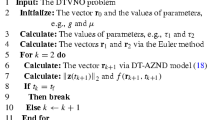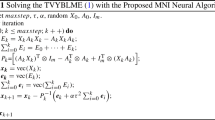Abstract
The online solving of a dynamic linear complex matrix equation (DLCME) is commonly encountered in many fields, and it exists for lots of engineering applications. For solving the DLCME, the gradient neural dynamics (GND) and the zeroing neural dynamics (ZND) are usually designed based on a predefined error function in scalar or matrix form to monitor the residual error convergence, respectively. In this paper, in order to improve the adaptability as the residual error decreasing with time and to release the limitation of convex activation function, an improved zeroing neural dynamics (IZND) model is proposed with a residual-based adaptive coefficient and a non-convex activation function. By using the Lyapunov stability theory, the global convergence and noise suppression of the proposed IZND model are theoretically discussed under the noise-free and noise-perturbed circumstances. Then, simulative verifications and a dynamic acoustic source localization application illustrate the efficacy and superiority of the proposed model for solving the DLCME. Comparing with some existing GND and ZND models, the proposed IZND model shows advanced performance in solution accuracy, noise suppression and convergence rate.







Similar content being viewed by others
References
Xie Z, Jin L, Luo X, Li S, Xiao X (2021) A data-driven cyclic-motion generation scheme for kinematic control of redundant manipulators. IEEE Transact Control Syst Technol 29(1):53–63. https://doi.org/10.1109/TCST.2019.2963017
Xie Z, Jin L, Du X, Xiao X, Li H, Li S (2019) On generalized rmp scheme for redundant robot manipulators aided with dynamic neural networks and nonconvex bound constraints. IEEE Transact Ind Inform 15(9):5172–5181. https://doi.org/10.1109/TII.2019.2899909
Katsikis VN, Mourtas SD, Stanimirović PS, Zhang Y (2021) Solving complex-valued time-varying linear matrix equations via qr decomposition with applications to robotic motion tracking and on angle-of-arrival localization. IEEE Transact Neural Netw Learn Syst. https://doi.org/10.1109/TNNLS.2021.3052896
Xiao X, Wei L, Fu D, Yan J, Wang H (2019) Noise-suppressing newton algorithm for kinematic control of robots. IEEE Access. https://doi.org/10.1109/ACCESS.2019.2937686
Huang H, Fu D, Xiao X, Ning Y, Wang H, Jin L, Liao S (2021) Modified newton integration neural algorithm for dynamic complex-valued matrix pseudoinversion applied to mobile object localization. IEEE Transact Ind Inform 17(4):2432–2442. https://doi.org/10.1109/TII.2020.3005937
Wang G, Huang H, Shi L, Wang C, Fu D, Jin L, Xiuchun X (2021) A noise-suppressing newton-raphson iteration algorithm for solving the time-varying lyapunov equation and robotic tracking problems. Inform Sci 550:239–251. https://doi.org/10.1016/j.ins.2020.10.032
Jin L, Yan J, Du X, Xiao X, Fu D (2020) Rnn for solving time-variant generalized sylvester equation with applications to robots and acoustic source localization. IEEE Transact Ind Inform 16(10):6359–6369. https://doi.org/10.1109/TII.2020.2964817
Zhang Y, Ge SS (2005) Design and analysis of a general recurrent neural network model for time-varying matrix inversion. IEEE Transact Neural Netw 16(6):1477–1490. https://doi.org/10.1109/TNN.2005.857946
Xu F, Li Z, Nie Z, Shao H, Guo D (2019) New recurrent neural network for online solution of time-dependent underdetermined linear system with bound constraint. IEEE Transact Ind Inform 15(4):2167–2176. https://doi.org/10.1109/TII.2018.2865515
Zhang Y, Chen K, Tan H-Z (2009) Performance analysis of gradient neural network exploited for online time-varying matrix inversion. IEEE Transaction Automatic Control 54(8):1940–1945. https://doi.org/10.1109/TAC.2009.2023779
Zhang Y, Chen K (2008) Comparison on zhang neural network and gradient neural network for time-varying linear matrix equation axb = c solving. In: 2008 IEEE International Conference on Industrial Technology, pp. 1–6.
Liao S, Liu J, Xiao X, Fu D, Wang G, Jin L (2020) Modified gradient neural networks for solving the time-varying sylvester equation with adaptive coefficients and elimination of matrix inversion. Neurocomputing 379:1–11. https://doi.org/10.1016/j.neucom.2019.10.080
Zhang Y, Jiang D, Wang J (2002) A recurrent neural network for solving sylvester equation with time-varying coefficients. IEEE Transact Neural Netw 13(5):1053–1063. https://doi.org/10.1109/TNN.2002.1031938
Guo D, Zhang Y (2012) Novel recurrent neural network for time-varying problems solving [research frontier]. IEEE Comput Intell Magazine 7(4):61–65. https://doi.org/10.1109/MCI.2012.2215139
Guo D, Zhang Y (2015) Znn for solving online time-varying linear matrix-vector inequality via equality conversion. Appl Math Comput 259:327–338. https://doi.org/10.1016/j.amc.2015.02.060
Xiao L, Zhang Y (2013) Different zhang functions resulting in different znn models demonstrated via time-varying linear matrix-vector inequalities solving. Neurocomputing 121:140–149. https://doi.org/10.1016/j.neucom.2013.04.041
Guo D, Zhang Y (2014) Zhang neural network for online solution of time-varying linear matrix inequality aided with an equality conversion. IEEE Transact Neural Netw Learn Syst 25(2):370–382. https://doi.org/10.1109/TNNLS.2013.2275011
Song J, Yam Y (1998) Complex recurrent neural network for computing the inverse and pseudo-inverse of the complex matrix. Appl Math Comput 93(2):195–205. https://doi.org/10.1016/S0096-3003(97)10064-9
Zhang Y, Li Z, Li K (2011) Complex-valued zhang neural network for online complex-valued time-varying matrix inversion. Appl Math Comput 217(24):10066–10073. https://doi.org/10.1016/j.amc.2011.04.085
Zhang Z, Lu Y, Zheng L, Li S, Yu Z, Li Y (2018) A new varying-parameter convergent-differential neural-network for solving time-varying convex qp problem constrained by linear-equality. IEEE Transact Auto Cont 63(12):4110–4125. https://doi.org/10.1109/TAC.2018.2810039
Xiao L (2015) A finite-time convergent neural dynamics for online solution of time-varying linear complex matrix equation. Neurocomputing 167:254–259. https://doi.org/10.1016/j.neucom.2015.04.070
Xiao L, Tao J, Dai J, Wang Y, Jia L, He Y (2021) A parameter-changing and complex-valued zeroing neural-network for finding solution of time-varying complex linear matrix equations in finite time. IEEE Transact Ind Inform 17(10):6634–6643. https://doi.org/10.1109/TII.2021.3049413
Jia L, Xiao L, Dai J, Qi Z, Zhang Z, Zhang Y (2021) Design and application of an adaptive fuzzy control strategy to zeroing neural network for solving time-variant qp problem. IEEE Transact Fuzzy Syst 29(6):1544–1555. https://doi.org/10.1109/TFUZZ.2020.2981001
Xiao X, Jiang C, Lu H, Jin L, Liu D, Huang H, Pan Y (2020) A parallel computing method based on zeroing neural networks for time-varying complex-valued matrix moore-penrose inversion. Inform Sci 524:216–228. https://doi.org/10.1016/j.ins.2020.03.043
Xiao L, Cao Y, Dai J, Jia L, Tan H (2021) Finite-time and predefined-time convergence design for zeroing neural network: Theorem, method, and verification. IEEE Transact on Ind Inform 17(7):4724–4732. https://doi.org/10.1109/TII.2020.3021438
Jiang C, Xiao X, Liu D, Huang H, Xiao H, Lu H (2021) Nonconvex and bound constraint zeroing neural network for solving time-varying complex-valued quadratic programming problem. IEEE Transact Ind Inform 17(10):6864–6874. https://doi.org/10.1109/TII.2020.3047959
Wang G, Huang H, Yan J, Cheng Y, Fu D (2020) An integration-implemented newton-raphson iterated algorithm with noise suppression for finding the solution of dynamic sylvester equation. IEEE Access 8:34492–34499. https://doi.org/10.1109/ACCESS.2020.2974753
Wang G, Hao Z, Zhang B, Jin L (2022) Convergence and robustness of bounded recurrent neural networks for solving dynamic lyapunov equations. Inform Sci 588:106–123. https://doi.org/10.1016/j.ins.2021.12.039
Liao B, Xiang Q, Li S (2019) Bounded z-type neurodynamics with limited-time convergence and noise tolerance for calculating time-dependent lyapunov equation. Neurocomputing 325:234–241. https://doi.org/10.1016/j.neucom.2018.10.031
Liao B, Wang Y, Li W, Peng C, Xiang Q (2021) Prescribed-time convergent and noise-tolerant z-type neural dynamics for calculating time-dependent quadratic programming. Neural Comput Appl 33(10):5327–5337. https://doi.org/10.1007/s00521-020-05356-x
Yan J, Xiao X, Li H, Zhang J, Yan J, Liu M (2019) Noise-tolerant zeroing neural network for solving non-stationary lyapunov equation. IEEE Access 7:41517–41524. https://doi.org/10.1109/ACCESS.2019.2907746
Chen D, Li X, Li S (2011) A novel convolutional neural network model based on beetle antennae search optimization algorithm for computerized tomography diagnosis. IEEE Transact Neural Netw Learn Syst. https://doi.org/10.1109/TNNLS.2021.3105384
Chen D, Li S, Wu Q (2020) A novel supertwisting zeroing neural network with application to mobile robot manipulators. IEEE transact neural netw learn syst 32(4):1776–1787. https://doi.org/10.1109/TNNLS.2020.2991088
Chen D, Li S, Lin F-J, Wu Q (2020) New super-twisting zeroing neural-dynamics model for tracking control of parallel robots: A finite-time and robust solution. IEEE Transact Cybern 50(6):2651–2660. https://doi.org/10.1109/TCYB.2019.2930662
Xiao X, Fu D, Wang G, Liao S, Qi Y, Huang H, Jin L (2020) Two neural dynamics approaches for computing system of time-varying nonlinear equations. Neurocomputing 394:84–94. https://doi.org/10.1016/j.neucom.2020.02.011
Li S, Li Y (2014) Nonlinearly activated neural network for solving time-varying complex sylvester equation. IEEE Transact Cybern 44(8):1397–1407. https://doi.org/10.1109/TCYB.2013.2285166
Zhang Y, Shi Y, Xiao L, Mu B (2012) Convergence and stability results of zhang neural network solving systems of time-varying nonlinear equations. In: 2012 8th International Conference on Natural Computation, pp. 143–147 . 10.1109/ICNC.2012.6234592
Li W, Xiao L, Liao B (2020) A finite-time convergent and noise-rejection recurrent neural network and its discretization for dynamic nonlinear equations solving. IEEE Transact Cybern 50(7):3195–3207. https://doi.org/10.1109/TCYB.2019.2906263
Ma Z, Yu S, Han Y, Guo D (2021) Zeroing neural network for bound-constrained time-varying nonlinear equation solving and its application to mobile robot manipulators. Neural Comput Appl 33(21):14231–14245. https://doi.org/10.1007/s00521-021-06068-6
Noroozi A, Oveis AH, Hosseini SM, Sebt MA (2018) Improved algebraic solution for source localization from tdoa and fdoa measurements. IEEE Wireless Commun Letters 7(3):352–355. https://doi.org/10.1109/LWC.2017.2777995
Du P, Zhang S, Chen C, Alphones A, Zhong W-D (2018) Demonstration of a low-complexity indoor visible light positioning system using an enhanced tdoa scheme. IEEE Photonics J 10(4):1–10. https://doi.org/10.1109/JPHOT.2018.2841831
Acknowledgements
This work is supported in part by the Natural Science Foundation of Guangdong Province, China (No. 2021A1515011847), in part by Postgraduate Education Innovation Project of Guangdong Ocean University (No. 202214, 202250, 202251, 202160), in part by the Special Project in Key Fields of Universities in Department of Education of Guangdong Province (No. 2019KZDZX1036), in part by the Key Lab of Digital Signal and Image Processing of Guangdong Province (No. 2019GDDSIPL-01).
Author information
Authors and Affiliations
Corresponding author
Ethics declarations
Conflict of interest
We wish to draw the attention of the Editor to the following facts, which may be considered as potential conflicts of interest and to significant financial contributions to this work. We confirm that the manuscript has been read and approved by all named authors and that there are no other persons who satisfied the criteria for authorship but are not listed. We further confirm that the other of authors listed in the manuscript has been approved by all of us and that the second author prepared the revision information letter and addressed most of the comments. We confirm that we have given due consideration to the protection of intellectual property associated with this work and that there are no impediments to publication, including the timing of publication, with respect to intellectual property. In so doing we confirm that we have followed the regulations of our institutions concerning intellectual property. We understand that the Corresponding Author is the sole contact for the Editorial process (including Editorial Manager and direct communications with the office ). He is responsible for communicating with the other authors about progress, submissions of revision and final approval of proof. We confirm that we have provided a current email address, which is accessible by the corresponding author, which has been configured to accept email from the Neural Computing and Applications Editorial Office.
Additional information
Publisher's Note
Springer Nature remains neutral with regard to jurisdictional claims in published maps and institutional affiliations.
Rights and permissions
About this article
Cite this article
Song, Z., Lu, Z., Wu, J. et al. Improved ZND model for solving dynamic linear complex matrix equation and its application. Neural Comput & Applic 34, 21035–21048 (2022). https://doi.org/10.1007/s00521-022-07581-y
Received:
Accepted:
Published:
Issue Date:
DOI: https://doi.org/10.1007/s00521-022-07581-y




